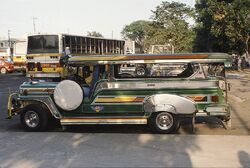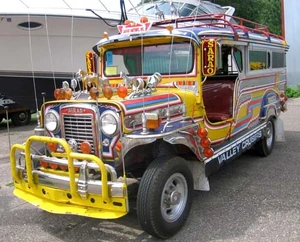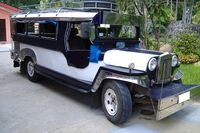 | |
| Manufacturer | Sarao, Alchris, Joeton, Teikoku & Aljin-Singcang, Morales, LGS, Hataw Motors, F.G. Motors, Armak, Lippad, A.Borja, D.F. Devera, Wild Country, Milwaukee, Skipper, Hebron, Obetski, Lawin, Society All Star, Boyong, Queens, Nazareth, Francisco, GabShop, David, Jems |
|---|---|
| Production | post World War II 1945 - present |
| Assembly | Philippines |
| Class | Minivan , Minibus, Jeep |
| Body style | Multi-purpose vehicle |
| Layout | Front-engine, rear-wheel drive |
| Platform | Isuzu Elf, Mitsubishi Canter, Custom Chassis |
| Engine |
Isuzu C190; 2.0 liters
Mitsubishi 6DR5 |
| Transmission |
4 speed Manual transmission
|
| Related | Jeep |
| Designer | Filipinos |

Jeepneys are a popular means of public transportation in the Philippines. They were originally made from US military jeeps left over from World War II and are well known for their flamboyant decoration and crowded seating. They have also become a symbol of Philippine culture.
History[]
When American troops began to leave the Philippines at the end of WWII, hundreds of surplus jeeps were sold or given to local Filipinos. The Filipinos stripped down and altered the jeeps to accommodate more passengers, added metal roofs for shade, and decorated the vehicles with
The jeepney rapidly emerged as a popular and creative way to re-establish inexpensive public transportation, which had been virtually destroyed during WWI-WWII. Recognizing the widespread use of these vehicles, the Philippine government began to regulate their use. Drivers now must have specialized licenses, regular routes, and reasonably fixed fares.
Types[]
Although several types of jeepneys have been produced, the jeepneys have only begun evolving recently, in response to environmental and economical concerns.

A jeepney ready for decoration
2nd-generation jeepneys[]
Fully assembled from refurbished engines, some also have air-conditioning units, most popularly in Makati. Most of these jeepneys have radically expanded passenger capacities, and are flamboyant and noisy. Many jeeps from this generation are notorious for belching smoke, and almost all are diesel.
3rd-generation jeepneys[]
These are jeepneys manufactured using new engine components. Many of these come with improved air-conditioning, and closely resemble a mini-bus.
Future generations[]
Electric jeepneys are being test-run in Makati. In response to calls for reduced greenhouse gas emissions and the rise in oil prices, a limited number of these have been deployed. A final plan to implement electric jeepneys is yet to be announced. Future jeepneys to be locally built will belong in this category.
LPG jeepneys[]
Seldom seen on the streets are special jeepneys fueled by LPG. This is in response for cleaner emissions and cheaper costs. Many existing jeepneys can be converted from diesel, in similar ways how existing gasoline cars can be converted to LPG. However, the cheaper cost of diesel or the complexity of the conversion makes the conversion unattractive.
E-jeepneys[]
E-jeepneys, short for electrical jeepneys, were the brainchild of Green Renewable Independent Power Producers, Inc. or GRIPP in partnership with Mr Robert Puckett, President of Solar Electric Company in the Philippines. These E-jeepneys or minibuses, under the support of Greenpeace started plying Manila / Makati City streets on July 1, 2008. 4 e-jeeps were launched by Makati mayor Jejomar Binay on 2007, with 2 prototypes from Guangzhou, China at P 371,280 each. "The first public transport system of its kind in South-East Asia," the vehicles can be charged by plugging into an electric socket, using power from biodegradable waste.[4] E-jeepneys would also soon begin commercial operations in Puerto Princesa, Bacolod and Baguio. The 2 new e-jeeps were made by the Motor Vehicle Parts Manufacturers Association of the Philippines (MVPMAP), while the first 4 units were made in China. The Land Transportation Franchising and Regulatory Board classified and registered them as LSV (low-speed vehicles) or 4-wheeled motor vehicles that use alternative fuel such as electricity and running a maximum 40 km per hour. The E-jeepney carries 17 passengers and can run 120 km on an 8-hour charge from an electric outlet.[5][6]
The e-jeepneys are locally fabricated and assembled in the Philippines by PhUV Inc., the business arm of the Motor Vehicle Parts Manufacturers Assn. of the Phils. (MVPMAP). It is equipped with either a 5 kW, 72-volt electric motor or a 7 kW, 84-volt one, either with or without transmission, with front end (hood & fender) or none, side or rear entry and front-facing or center-facing rear seats. It is the first electric vehicle granted an orange license plate by the Land Transportation Office (LTO) to operate on Philippine roads.
Since its launch in July 2008, e-jeepneys are used by schools, resorts, theme parks, industrial zones, LGUs and other entities such as the Makati LGU, de la Salle Dasmarinas in Cavite, Plantation Bay in Cebu, Puerto Princesa City in Palawan, Embarcadero in Bicol, Hacienda San Benito in Lipa, the Bangko Sentral ng Pilipinas in Quezon City, the House of Representative (Congress), Ilocos Sur provincial government and soon, the Pasig City LGU.
The biggest mass application of the e-jeepney in the whole of Asia is the Makati Green Route (MGR), where some ten e-jeepneys now ply the Legazpi and Salcedo routes for free under the Climate Friendly Cities (CFC) program of the Institute for Climate and Sustainable Cities (iCSC). A third route, the Rockwell loop, will soon be implemented. Under the CFC program, the e-jeepneys are one of three major components of the program. The other two are a renewable energy plant (a biodigester using biodegradable household wastes) and a terminal/charging station for e-jeepneys. Both of these the Makati and Puerto Princesa LGUs have invested in to complete the "green" loop.
Manufacturers[]

A jeepney in Manila.
Although the original jeepneys were simply refurbished military jeeps (Willys & Ford), modern jeepneys are now produced by independently owned workshops and factories in the Philippines. In the central Philippine island of Cebu, the bulk of jeepneys are built from second-hand Japanese trucks, originally intended for cargo. These are euphemistically known as "surplus" trucks.
Recently the jeepney industry has faced threats to its survival in its current form. Most of the larger builders have gone bankrupt or have switched to manufacturing other products. Currently there are 2 classes of jeepney builders in the Philippines.[1] The backyard builders produce 1-5 vehicles a month, source their die-stamped pieces from one of the larger manufacturers, and work with used engines and chassis from salvage yards (usually the Isuzu 4BA1, 4BC2, 4BE1 series diesel engines or the Mitsubishi Fuso 4D30 diesel engines). The second type is the large volume manufacturer. They have 2 sub groups: the PUJ (Public Utility Jeep) and the large volume metal-stamping companies that supply parts as well as complete vehicles.
The jeepney builders in the past were mostly based in Cebu City and Las Piñas City. With the recent slowdown of sales, many of the smaller builders have gone out of business. The largest manufacturer of owner-type jeeps in the Philippines is David Motors Inc. in Quezon City, located on the north side of Metro Manila. The largest manufacturer of vintage style army jeepneys is MD Juan.
Other manufacturers/marks include Mega (which also produces the Lanceta line of jeepneys, in Lipa), Malagueña (whose factory in Cavite was the site of one of the very first Yield Stops of The Amazing Race),[2] LGS Motors, Morales, Hebron, Marinel (jeepney makers based in Rizal which is popular for their patok (popular) jeepneys which are equipped with high-powered sound systems, aggressive racing themes and lettering/fonts, and their speed—some even achieving a "lowered"-style) and Sarao Motors , and Armak (one of the largest). Another manufacturer PBJ motors manufactured jeepneys in Pampanga using techniques derived from Sarao Motors. Armak now sells remanufactured trucks and vehicles as an adjunct, alongside its jeepneys.
In Cebu, popular jeepney manufacturers are Chariot and RDAK, known for its "flat-nosed" jeepneys made from surplus Suzuki mini-vans and Isuzu Elf trucks, which are no longer in use in Japan. These are equipped with high-powered sound systems, racing themes, and are bigger and taller than those in Manila.

A passad jeepney of Iloilo City.
In Iloilo City, jeepneys called passad are known for as replicas of sedans or pick-up trucks. The passad jeepneys' body much lower which resembles more of a sedan chassis with elongated body.
Passenger jeepneys are also facing increasing restrictions and regulations for pollution controls, as they increase traffic volume and consume lots of fuel. A recent study published in a Metro Manila newspaper compared the fuel use of a 16-passenger jeepney to a 54-passenger air-conditioned bus and found that the fuel consumption for both was the same. With major roads clogged by empty jeepneys seeking fares, there is pressure to remove them from the streets of Manila and other cities.
The cost for a new jeepney will also rise due to the increased costs of raw materials and the need to use new engines. The supply of remanufactured engines is slowly dropping with wear and age, and the number of engine rebuilders diminishes.
The jeepney industry has evolved more quickly in the past 2 years than it has in the past 50 years. Many local manufacturers are moving to build modern-looking jeepneys such as Hummer lookalikes and oversized Toyota van-style passenger jeepneys with Toyota headlights, hoods and bumpers. Manufacturers in Nueva Ecija also started making jeepneys with fronts resembling AUVs like the Honda CR-V or the Toyota Tamaraw. Already in production is a jeepney the size of a small bus and is equipped with state-of-the-art vehicle technology (brand-new engine and drivetrain) and Thermo-King-brand airconditioning intended for buses. Local automobile parts manufacturers are now planning the production of electric jeepneys.
References[]
- ↑ Cite error: Invalid
<ref>tag; no text was provided for refs namedreu1 - ↑ Jimenez-David, Rina (2004-09-24). "Truly amazing". Asian Journal. http://www.asianjournal.com/cgi-bin/view_info.cgi?code=6872. Retrieved 2008-02-27. Template:Dead link